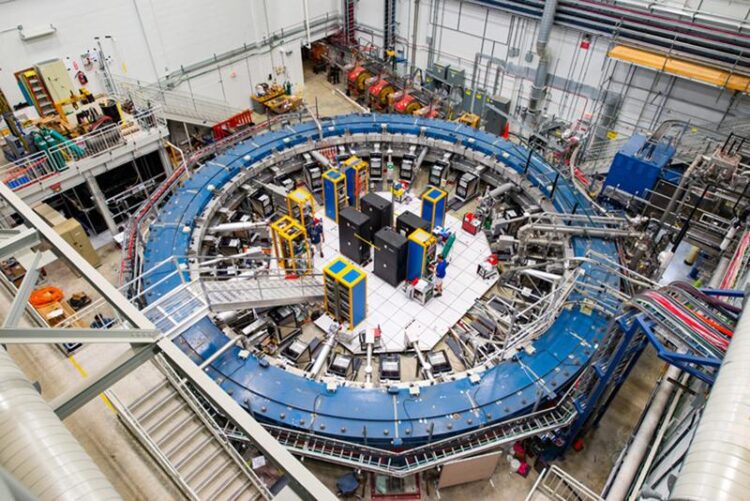Muon g-2: Small particle with huge impact

The Muon g-2 ring
Image: Reidar Hahn/Fermilab
Prof. Dominik Stöckinger from the Institute of Nuclear and Particle Physics at TU Dresden is involved in the large-scale muon g-2 experiment at Fermilab in the USA. Now the collaboration is on the verge of a sensational moment that could rewrite the history of particle physics and perhaps even provide clues to yet unknown particles in the universe. For many years, he and his wife Dr. Hyejung Stöckinger-Kim, also a scientist at the Institute of Nuclear and Particle Physics, have devoted themselves to this topic from the theoretical side.
The Standard Model of particle physics describes the essential knowledge about all known elementary particles and their interactions. Nevertheless, there are some reasons to believe that physics beyond the Standard Model exists. Numerous open questions, such as the existence of dark matter or the mass of neutrinos, cannot be explained by the Standard Model alone.
In large-scale experiments, international collaborations of scientists are searching for answers by experimentally proving the theoretical predictions. At the Fermi National Accelerator Laboratory, short Fermilab, in Illinois, USA, one of these large-scale experiments is on the verge of a major breakthrough. Using measurements of the muon’s anomalous magnetic moment, known as “g-2,” scientists will be able to confirm all known interactions and elementary particles, from electrons to photons to the Higgs boson. Muons are similar to electrons in many of their properties, they are just much heavier and are the main component of secondary cosmic rays. All interactions and elementary particles contribute with their respective properties to the “g-2” of the muon. It is one of the most precisely calculated and measured quantities in elementary particle physics. However, an experiment carried out in 2001 revealed a significant difference between the experimentally determined value and that of the Standard Model. Could hitherto unknown particles be responsible for this? Perhaps. Unfortunately, the experiment was not sensitive enough to rule out random fluctuation of the measured value as cause for the deviation.
Therefore, new, extremely precise measurements were performed at Fermilab in 2018 to recheck the “g-2” value of the muon. Prof. Dominik Stöckinger from the Institute of Nuclear and Particle Physics at TU Dresden was involved in the mammoth project from the very first moment: “The muon g-2 experiment at Fermilab has the potential to be the first experiment to directly prove the existence of physics beyond the Standard Model under man-made, controlled laboratory conditions. The analysis of the data is extremely challenging, as an accuracy of better than one in a million is the goal, and the so-called “unblinding,” of the data, is a big moment for the physics world. If the experiment yields a different value than that of the Standard Model, it means that our current understanding of physics is incomplete, and it could point to the existence of additional particles or hidden subatomic forces. It would open the door to exciting new areas of science.”
Together with his wife, Dr. Hyejung Stöckinger-Kim, the theoretical physicist is working to evaluate the Standard Model by making even more precise calculations and proposing alternative theories: “What if there are other particles and how much would “g-2″ change then?” – is among the guiding questions of their work. So, it is relatively unimportant what value the experiment yields, the Stöckingers already have a theoretical explanation for it due to their extensive preliminary work, which they will also publish after the unblinding of the data.
The presentation of the Fermilab results will take place during a press conference on April 7, 2021, 12:00 – 12:45 pm US CT.
Caption: The Muon g-2 ring sits in its detector hall amidst electronics racks, the muon beamline, and other equipment. This impressive experiment operates at negative 450 degrees Fahrenheit and studies the precession (or wobble) of muons as they travel through the magnetic field. Copyright: Reidar Hahn/Fermilab
Contact for scientific information:
Prof. Dominik Stöckinger
Institute of Nuclear and Particle Physics
Email: dominik.stoeckinger@tu-dresden.de
More information:
https://fnal.zoom.us/j/95785531415?pwd=V1N4bjlNMEJTRlVvYzZMU2NJRzVXdz09 Press conference link
https://muon-g-2.fnal.gov/ Website of the muon g-2 experiment at Fermilab
Media Contact
All latest news from the category: Physics and Astronomy
This area deals with the fundamental laws and building blocks of nature and how they interact, the properties and the behavior of matter, and research into space and time and their structures.
innovations-report provides in-depth reports and articles on subjects such as astrophysics, laser technologies, nuclear, quantum, particle and solid-state physics, nanotechnologies, planetary research and findings (Mars, Venus) and developments related to the Hubble Telescope.
Newest articles

You are What You Eat—Stanford Study Links Fiber to Anti-Cancer Gene Modulation
The Fiber Gap: A Growing Concern in American Diets Fiber is well known to be an important part of a healthy diet, yet less than 10% of Americans eat the minimum recommended…

Trust Your Gut—RNA-Protein Discovery for Better Immunity
HIRI researchers uncover control mechanisms of polysaccharide utilization in Bacteroides thetaiotaomicron. Researchers at the Helmholtz Institute for RNA-based Infection Research (HIRI) and the Julius-Maximilians-Universität (JMU) in Würzburg have identified a…

ASXL1 Mutation: The Hidden Trigger Behind Blood Cancers and Inflammation
Scientists show how a mutated gene harms red and white blood cells. LA JOLLA, CA—Scientists at La Jolla Institute for Immunology (LJI) have discovered how a mutated gene kicks off…



